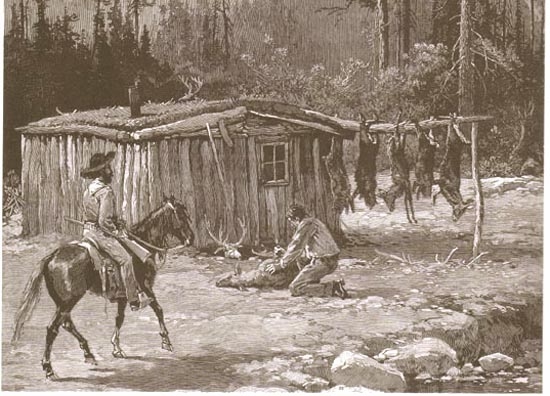
Trappers' Cabin, Harper's Weekly, 1890, drawing by Charles Graham
The picture is a fairly accurate depiction of an early cabin as would have
been constructed by French-speaking trappers from Missouri. The French were referred to by
one of Ashley's company, Jim Clyman, as "St. Louis gumboes." The cabin or
poteaux en terre, "posts in the ground," was built by digging a trench about two
feet deep and placing logs upright in a pallisade to form the walls. The spaces between
the logs would be filled with bousillage, a mixture of clay and grass or deer hair. Note the sod roof. The "window" in
the door would probably have been made of paper soaked in lard. The typical log cabin with horizontal logs, a
maison de pieces sur pieces,
was used by Anglo-Americans. The advantage of a poteaux en terre was that it could be construct by
one man. Construction of an Anglo-Saxon cabin required two men.
The end of the rendezvous system, did not mean the
end of trapping or of furs. Supplies were provided to trappers and furs purchased at various forts
established by the fur companies such as Fort William established by Sublette and Campbell, Bent's Fort in Colorado, or Fort Pierre operated by
the American Fur Company. A new emphasis was placed on buffalo robes as a result of the loss of demand for
beaver pelt. Beaver fur prices on the east coast fell from $4.50 a pound in 1832 to $2.50 a pound by 1840. But at the
same time buffalo robes doubled in value. Thus in 1840, some 100,000 robes came into St. Louis.
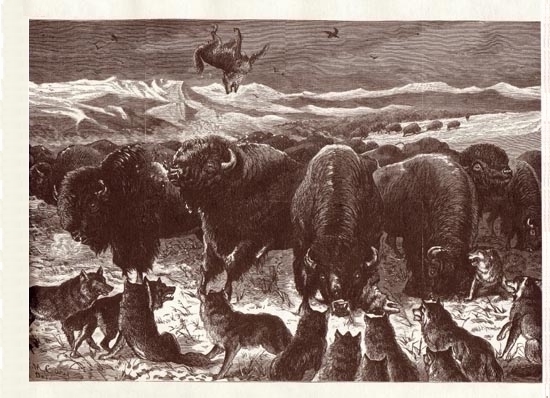
Buffalo Bulls Protecting Their Herd, W. M. Cary, Harper's Weekly, 1873
Wolves would follow buffalo herds, picking off calves or the elderly. The wolves were, however,
not a match for the bulls who could easily with their horns, as illustrated in the woodcut, flip a wolf into the air and then trample the
wolf to death. The real decimation of the buffalo population, however, did not start until the
1870's when wholesale slaughter began.
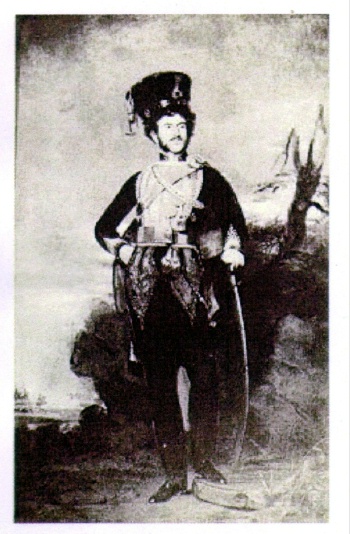 Captain Sir William Drummond Stewart, painting by Alfred Jacob Miller.
Captain Sir William Drummond Stewart, painting by Alfred Jacob Miller.
Alfred Jacob Miller followed Sir William to the Stewart Family estate, Murthly Castle in Pirthshire. There Sir William
set up a studio for Miller where many of the paintings by Miller of fur trapping days were painted. Accompanying
Sir William to Scotland were several American Bison and several American Indians who acted as game keepers.
The Indians would occasionally get drunk and would then hitch the bison to Sir William's carriage and take it through
town. A creole half breed acted as Sir William's butler. It was a combination of peculiarities of
English Common Law and personal tragedy that enabled many of the paintings to be returned to the
United States. Murthly Castle was entailed. Dating to the reign of Edward I it was not unusual for
estates to be held in "fee tail" under the principles of primogenture; that is, an estate held in
fee tail would descend to the oldest son of the original owner. The son, however, would hold the
estate only for his life and could not mortgage to convey the property. Upon his death, the estate would then descend to
his oldest son, and so on in perpetuity by action of law, thus insuring that the property would always be held within the family. The ownership of
estates in such a manner was central to the plots of Emily Bronte's Wuthering Heights and
Jane Austen's Pride and Prejudice. Entailed estates were abolished in England in 1925, see
Law of Property Act (15 & 16 Geo. 5, ch. 20, § 131), but not abolished in Wyoming until 1939.
Sir William before coming to America got into a family dispute whereby he vowed he would never again
sleep under the roof of Murthly Castle. His older brother, John, 6th Baronet of Murthly, died childless and, thus,
the estate and title descended to Sir William. Although Sir William returned to Scotland, he maintained
his vow and lived at first in a game keeper cottage. Later he had an extension built onto
the castle in which he would sleep. Servants were instructed to awaken him if he ever fell asleep under
the orginal roof. By an early unhappy marriage, Sir William had one son, George, to whom in
normal line of succession the tile and the estate would descend. George, however, at the time of the
Battle of Balaclava during the Crimean War was a member of the 13th Hussars remembered in Alfred,
Lord Tennyson's tribute. George was one who did not return:
THE CHARGE OF THE LIGHT BRIGADE
Alfred, Lord Tennyson
|
1.
Half a league, half a league,
Half a league onward,
All in the valley of Death
Rode the six hundred.
"Forward, the Light Brigade!
"Charge for the guns!" he said:
Into the valley of Death
Rode the six hundred.
2.
"Forward, the Light Brigade!"
Was there a man dismay'd?
Not tho' the soldier knew
Someone had blunder'd:
Their's not to make reply,
Their's not to reason why,
Their's but to do and die:
Into the valley of Death
Rode the six hundred.
* * * *
5.
Cannon to right of them,
Cannon to left of them,
Cannon behind them
Volley'd and thunder'd;
Storm'd at with shot and shell,
While horse and hero fell,
They that had fought so well
Came thro' the jaws of Death
Back from the mouth of Hell,
All that was left of them,
Left of six hundred.
6.
When can their glory fade?
O the wild charge they made!
All the world wondered.
Honor the charge they made,
Honor the Light Brigade,
Noble six hundred.
|
Sir William was not, however, completely childless, having had a son by a lady saloon keeper
in America. In his will, he left the estate to that son, Frank Nichols. The estate being entailed, however,
could not be left to an illegimate son. Thus, cousins inherited the castle, but the contents, being personal
property, were not entailed and went to Nichols. In an act of revenge to his cousins, Nichols cleaned the castle out and sold the paintings and other
items at auction in Endinburgh. There, many items were purchased by Americans and returned
to the United States. The bisons made their way to a local zoo where their descendants continue to
live.
In addition to Sir William Stewart, other members of the British peerage conducted early expeditions to the West. Among the more
notable was Sir St. George Gore's 1855-56 hunting trip out of Fort Laramie guided by Jim Bridger. Bridger was paid $750 for his services.
Sir St. George, accomanied for part of the journey by William Wentworth-Fitzwilliam (later the Sixth Earl of Fitzwilliam of Irland, Fourth Earl Fitzwilliam of England), did it up in
fine style with 40 attendants (including one individual whose function was to tie fishing flies),112 horses, 12 yoke of oxen, 6 wagons, 23 wheeled carts, 75 shooting rifles, 14 dogs, china, crystal, linens,
and a collapsible brass bed used in a green and white striped tent in whch, much to the consternation of Jim Bridger, his lordhip would
sleep late. Fitzwilliam later was to be the owner of the largest private "house" in Britain, a modest little structure with
a 600 foot long facade and 200 rooms. On the trip, 6,000 bison, 1,600 elk and 105 grizzlies were killed.
At Fort Union, Sir St. George, in a dispute relating to the sale of some of the equipment,
ordered everything burned except the arms and alcohol. While the wagons and
carts burned, the spectators consumed the alcohol. The last item thrown into the confligration was the
expedition journal. The expedition continued, however, until it came to an unexpected halt
near present day Sundance when the Sioux stole the expedition's horses, arms and
clothes. As a result, Sir St. George offered to raise a private army to do to the Sioux what he did to
the Bison. The American Army refused the offer.
In 1874, Windham Thomas Wyndham-Quin, 4th Earl of Dunraven (See Yellowstone), toured the Upper Yellowstone. The dapper Dunraven, a
noted world traveler and war correspondent, with Texas Jack Omohundro as his guide, toured Yellowstone. Two years later
his account of his travels was published as Dunraven's The Great Divide: A Narrative of Travels in the
Upper Yellowstone in the Summer of 1874. With Maps and numerous
striking full page-Illustrations by Valentine W. Bromley. The book was
an immediate success. Thus, at least among the very wealthy, it became almost de regueur to take
extensive hunting trips to the American West. Among those who came to Wyoming, as discussed on later pages,
were Sir Horace Plunkett and Moreton Frewen and his brother Richard Frewen. Dunraven established a
hunting preserve and hotel at Estes Park, Colorado, and Frewen entertained the wealthy with
elaborate hunting trips from his log castle on Powder River.
For the most part, trappers had a short life expectancy. James O. Pattie (1804-c1850) in his
1831 Personal Narative recounted his trapping adventures between 1827 and 1830 through the Rockies and to
California. He observed that of 116 men who set out from St. Louis in 1824, by 1827 most were dead:
Some had died by lingering diseases, and others by the fatal ball or
arrow, so that out of 116 men, who came from the United States in 1824,
there were not more than sixteen alive. Most of the fallen were as true
men, and as brave as ever poised a rifle, and yet in these remote and
foreign deserts found not even the benefit of a grave, but left their
bodies to be torn by the wild beasts, or mangled by the Indians. When I
heard the sad roll of the dead called over, and thought how often I had
been in equal danger, I felt grateful to my Almighty Benefactor, that I
was alive and in health. A strong perception of the danger of such courses
as mine, as shown by the death of these men, came over my mind, and I
made a kind of resolution, that I would return to my home, and never
venture into the woods again. Among the number of my fallen companions,
I ought not to forget the original leader of our company, Mr. Pratte,
who died in his prime, of a lingering disease, in this place.
[Writer's notes: Mr. Pratte, Sylvestre Sebastien Pratte, born 1799. Pratte is believed to
have died along the headwaters of the Platte River in 1827 or 1828. Pratte was the son of Bernard Pratte a partner in
Pratte, Chouteau and Company, agents for the American Fur Company.]
James Pattie's father, Sylvester Pattie, was on the expedition with his son. The elder Pattie died
in a Mexican prison when the Patties' passport was not accepted by a local
commander. Other trappers lost their lives to Indians and wild animinals.
Jacques LaRamee [as previously observed, possibly Missouri free trapper Louis Lorimier, Jr.], after whom the river, the mountain, the county, the fort and the city are named,
disappeared to do beaver trapping
along a tributary of the Platte. Bridger in 1868 told John Hunton that Bridger had been a part of the
1821 search party which found only a half completed cabin and a broken beaver trap. Bridger indicated that
two years later he was told by the Arapaho that they had killed LaRamee and
placed his body under the ice behind a beaver dam.
Three of the five Sublette Brothers died early: Pickney was killed by the
Blackfeet at the Battle of Pierre's Hole in 1832;
Milton died of a leg infection at Fort Laramie after several amputations; and Andrew died as a result
of being mauled by a grizzly in California. Andrew was doing battle with a grizzly when a second grizzly came out
of the woods. Notwithstanding that Andrew's gun was out of amnuition, in a fierce battle he
was able to dispatch both grizzlies with a knife. Andrew and his dog, however, were badly
mauled. Mortally wounded, Andrew lingered for a while in his bed. His faithful dog stayed by the bedside until Andrew
expired. The dog followed his master's body to the grave side. There the dog stayed, refusing to
leave, and refusing drink and food until he too died.
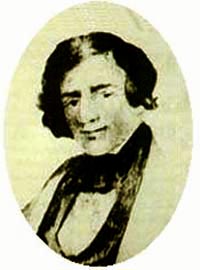 Jedediah Smith
Jedediah Smith
Jedediah Strong Smith was also attacked by a grizzly. Jim Clyman described the
surgery which may have saved Smith's life (Punctuation, capitalization at beginings of sentences, and paragraphing have
been added for purposes of clarity. Original spelling and mid-sentence capitalization are as in
original.):
The Crow Indians being our place of destination, a half Breed by the name of
Rose who spoke the crow tongue was dispached ahead to find the Crows and
try to induce some of them to come to our assistance. We to travel directly
west as near as circumstances would permit. Supposing we ware on the waters
of Powder River, we ought to be within the bounds of the Crow country.
Continueing five days travel since leaveing our given out horses and
likewise Since Rose left us.
Late in the afternoon while passing through
a Brushy bottom, a large Grssely came down the vally, we being in single file
men on foot leding pack horses. He struck us about the center. Then turning,
ran paralel to our line.
Capt. Smith being in the advanc. He ran to the open
ground and as he immerged from the thicket, he and the bear met face to face.
Grissly did not hesitate a moment but sprung on the capt, taking him by the
head. First pitcing sprawling on the earth, he gave him a grab by the middle.
Fortunately cathing by the ball pouch and Butcher Kife which he broke, but
breaking several of his ribs and cutting his head badly.
None of us having any sugical Knowledge what was to be done, one Said, "come take hold," and he
wuld say, "why not you?" So it went around. I asked Capt what was best. He said,
"One or 2 for water and if you have a needle and thread git it out and sew
up my wounds around my head," which was bleeding freely. I got a pair of
scissors and cut off his hair and then began my first Job of dessing wounds.
Upon examination, I, the bear had taken nearly all his head in his capcious
mouth, close to his left eye on one side and clos to his right ear on the
other, and laid the skull bare to near the crown of the head, leaving a white
streak whare his teeth passed. One of his ears was torn from his head out to
the outer rim. After stitching all the other wounds in the best way I was
capabl and according to the captains directions, the ear being the last. I
told him I could do nothing for his Eare. "0 you must try to stich up some
way or other," said he. Then I put in my needle stiching it through and
through and over and over, laying the lacerated parts togather as nice as
I could with my hands.
Water was found in about ame mille, when we all moved
down and encamped. The captain being able to mount his horse and ride to
camp, whare we pitched a tent, the onley one we had, and made him as
comfortable as circumtances would permit. This gave us a lisson on the
charcter of the grissly Baare which we did not forget.
In 1831, Jedediah Smith was guiding a wagon train to Sante Fe. The train took the
shorter Cimmarron Cutoff notorious for its lack of water. With the caravan running short of
water, Smith volunteered to seek out a spring. Along the Cimmarron, Smith was killed by a Comanchee arrow.
His body was never recovered. In his last letter to
Robert Cambell's brother Hugh, Smith expressed the hope of seeing his protégé but one more time,
"Oh is it possible I Shall never again See him in the Land of the living?"
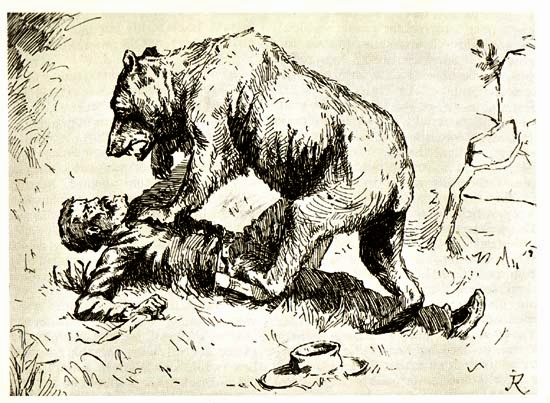
"The Bar Tore Carver to Pieces," Frederic Remington, 1888
Hugh Glass survived a mauling by a grizzly, was left for dead by his
compatriots, and crawled with a broken leg, on two elbows, and one knee over one hundred miles. His life was
probably saved by another grizzly and by maggots in his wounds. On the journey, Glass passed out and awakened to
find the grizzly licking the maggots out of Glass's open wounds. There is evidence both scientifically and anecdotally
that saliva contains antiseptic aspects.
Some animal saliva may contain lysozyme, an enzyme that destroys harmful bacteria.
The licking may provides direct stimulation of the tissues and small blood vessels surrounding the wound site. Because of
risk of infection, it is not recommended that one allow animals to lick wounds.
The use of maggots to debride wounds has been traced back to the
Napoleonic Wars. In this country, the first intentional use of maggots for such purposes was apparently by a Confederate surgeon, J. F. Zacharias,
at Danville, Virginia to aid in the treatment of gangrene. See, Baer, William S.,
"The Treatment of Chronic Osteomylitis with the Maggot (Larva of the Blow Fly),"
Journal of Bone and Joint Surgery, 1931. In spite of, or maybe because of, the unorthodox treatment of his wounds by the
maggots and the bear, Glass fully recovered and returned to trapping. Along with
two companions, he was killed by Indians in 1833.
John Hoback, after whom Hoback Basin, Hoback River, Hoback Peak, and numerous other places in the West are named,
was killed along with the Reed wintering brigade by Indians in 1813.
During the War of 1812, Astoria was surrendered to the
British. One of the former members of the company at Astoria, Gabriel Franchère, commenced his epic journey by canoe and
foot across the continent to Montreal. In his 1820 account of his adventures,
Relation d'un voyage a la Cote du NordOuest de l'Amerique septentrionale darts les anndes 1810'14 (1854 translation by
Jedediah Vincent Huntington), Franchère reported the death of Hoback (spelled "Hubbough"):
On the 17th, the fatique I had experienced the day before, on horseback,
obliged me to re-embark in my canoe. About eight o'clock, we passed a
little river flowing from the N.W. We perceived, soon after, three canoes, the persons in
which were struggling with their paddles to overtake us. As we were still pursuing our
way, we heard a child's voice cry out in French -- "arrétez donc, arrétez donc" -- (stop! stop!).
We put ashore, and the canoes having joined us, we perceived in one of them the wife
and children of a man named Pierre Dorion, a hunter, who had been sent
on with a party of eight, under the command of Mr. J. Reed, anomg the Snakes, to join there
the hunters left by Messers. Hunt and Crooks, near Fort Henry, and to secure horses
and provisions for our journey. This woman informed us, to our no small dismay, of the
tragical fate of all those who composed that party. She told us that in the month
of January, the hunters being dispersed here and there, setting their traps for the beaver,
Jacob Regner, Gilles Leclerc, and Pierre Dorion, her husband, had been
attacked by the natives. Leclerc, having been mortally wounded, reached her
tent or hut, where he expired in a few minutes, after having announced to her
that her husband had been killed. She immediately took two horses that were near
the lodge, mounted her two boys upon them, and fled in all haste to the wintering
house of Mr. Reed, which was about five days' march from the spot where her
husband fell. Her horror and disappointment were extreme, when she found the house -- a
log cabin -- deserted and upon drawing nearer, was soon convinced, by the
traces of blood, that Mr. Reed also had been murdered. No time was to be
lost in lamentations, and she had immediately fled toward the mountains south of the
Walawalla, where, being impeded by the depth of the snow, she was forced
to winter, having killed both the horses to subsist herself and her children. But
at last, finding herself out of provisions, and the snow beginning to
melt, whe had crossed the mountains with her boys, hoping to find some more humane Indians,
who would let her live among them till the boats from the fort below should be
ascending the river in the spring, and so reached the banks of the
Columbia, by the Wallawalla. Here, indeed, the natives had received her with much
hospitality, and it was the Indians of the wallawalla who brought her to
us. We made them some presents to repay their care and pains, and they
returned well satisfied.
The persons who lost their lives in this unfortunate wintering party,
were Mr. John Reed, (clerk), Jacob Rener, John Hubbough, Pierre Dorion (hunters),
Gilles Leclerc, François Landry, J. B. Turcotte, André la Chapelle and
Pierre De Launay, (voyageurs).
Franchère notes that Turcotte died of "King's Evil" and that DeLaunay left Reed in the
autumn and was never heard from again. [Writer's notes: Alexander Ross's 1849 account,
Adventures of the First Settlers on the Oregon or Columbia River
: Being a Narrative of the Expedition Fitted Out by John Jacob Astor,
to Establish the Pacific Fur Company: With an Account of Some Indian Tribes
on of the Coast of the Pacific quotes Marie Dorion as indicating that
LeClerc died on the trip back to Reed's house. Irving's account also has LeClerc dieing on the
trip back. Marie Dorion died in 1850 near Salem, Oregon. Pierre Dorion was the
interpreter for the Hunt party and left St. Charles one step ahead of a
warrant sworn out by Manuel de Lisa for an unpaid debt. "King's Evil," a tubercular swelling of the lymph
nodes of the neck, so called because it could allegedly be cured by the touching of the
swelling by the royal hand.]
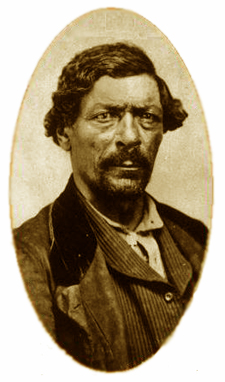
James Pierson Beckwourth.
Jim Beckwourth (1798-1866), who had participated in Ashley's expeditions was one of the few
mountain men to lead a full life. He acted as a scout in the Second Seminole War in Florida, went to
California where he rustled horses from Spanish-owned ranches, ran a store in Denver and in his
60's acted as a guide for the army including at the Battle of Sand Creek. In 1866, he acted as
a scout for Col. Henry B. Carrington's expeditions into northern Wyoming. Col. Carrington in his
report of November 14, 1866, noted Beckwourth's passing:
Only valuable information since last week's mail is that Crows in large numbers have camped near Fort C.F. Smith, and are friendly.
Guide Beckwith [sic] died while in their village.
William Guerrier blew himself to Kingdon Come during the winter of 1857-58 when one of his employees left a
keg of black powder on the front of a wagon with the lid off. Guerier, sometimes referred to in government
records as "Bill Garey", in stepping on the the tongue of the wagon accidently allowed some embers from his pipe to fall into the
open keg. Guerrier was noted as a proficient interpreter for the Cheyenne and ran the first cattle ranch in Wyoming near
Register Cliff near present day Guernsey. Guerrier, son-in-law of Gray Thunder, was the father of Edmond Guerrier, a survivor of
the Battle of Sand Creek. Edmond testified before Congress as to the slaughter. Edmond, college educated, followed in
his father's footsteps and served as an interpreter for the government. George Armstrong Custer in his
1874 My Life on the Plains, noted Guerrier's services in an 1867 meeting between General Hancock and
Roman Nose. Custer described entering a hastily deserted Cheyenne Lodge:
To complete the picture of an Indian lodge, over the fire hung a
camp-kettle, in which, by means of the dim light of the fire, we could see
what had been intended for the supper of the late occupants of the lodge.
The doctor, ever on the alert to discover additional items of knowledge,
whether pertaining to history or science, snuffed the savory odors which
arose from the dark recesses of the mysterious kettle. Casting about the
lodge for some instrument to aid him in his pursuit of knowledge, he found
a horn spoon, with which he began his investigation of the contents,
finally succeeding in getting possession of a fragment which might have
been the half of a duck or rabbit, judging merely from its size. "Ah!"
said the doctor, in his most complacent manner, "here is the opportunity I
have long been waiting for. I have often desired to test and taste of the
Indian mode of cooking. What do you suppose this is?" holding up the
dripping morsel. Unable to obtain the desired information, the Doctor,
whose naturally good appetite had been sensibly sharpened by his recent
exercise a la quadrupede set to with a will and ate heartily of the
mysterious contents of the kettle. "What can this be?" again inquired the
doctor. He was only satisfied on one point, that it was delicious-a dish
fit for a king.
Just then Guerrier, the half-breed, entered the lodge. He could
solve the mystery, having spent years among the Indians. To him the doctor
appealed for information. Fishing out a huge piece, and attacking it with
the voracity of a hungry wolf, he was not long in determining what the
doctor had supped so heartily upon. His first words settled the mystery:
"Why, this is dog." I will not attempt to repeat the few but emphatic words
uttered by the heartily disgusted member of the medical fraternity as he
rushed from the lodge.
A description of the interior of a tipi has been provided to us by
the Earl of Dunraven. He wrote that each tipe was shared by seveal families, their space
divided by a wicker-work wall, all spaces, however, opening to the common fire. Just as it is
bad form in a modern fraternal lodge, to cross between the station of the
presiding officer and the alter, in the tipi, Dunraven observed, the "fire is
common property, and has a certain amount of reverence paid to it. It is considered
very bad manners, for instance, to step between the fire and the place where the head
man sits."
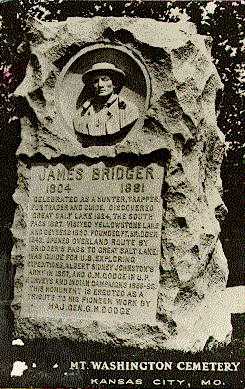
Bridger Grave, Mount Washington Cemetery, Kansas City
Although Bridger could not read or write he loved to be read
to, even to the extent that at one point he employed an
individual to read to him. He was particularly fond of Shakespeare and managed to memorize a large number of
passages which he would recite. Two explainations have been given for Bridger's love
of Shakespear. One is that Sir St. George Gore introduced Bridger to the bard. Another was given by
Eugene F. Ware (1841-1911) in his 1911 book, The Indian War of 1864:
The largest building in camp[See Ft. Laramie]
was called Bedlam. It was the two-story large hospital building
fronting on the parade-ground, and the upper part of it was used
for theatricals at times. There were always some soldiers who were
good at private theatricals, and occasionally there was one who had
been an actor. So, during the long and tiresome winter evenings there
were theatrical entertainments frequently. They were generally of some
light, witty, flashy kind, with an occasional heavy piece from Shakespeare.
Bridger had seen a couple of Shakespeare's pieces well played at the post,
and concluded he would like to have somebody read Shakespeare to him. So,
he had the sutler, Mr. Ward, send and get him a copy of Shakespeare, and
Bridger got a man, a soldier, to start reading it to him. One evening while
sitting in front of the adobe fireplace reading Shakespeare the soldier
got to reading in the play where the eyes of the two boy princes were put
out. After it had been read Bridger says, "Did he do that?" and when the
reader said, "Yes," Bridger pulled the book from him and said, "By thunder,
that is what I think of him," and threw the book into the fire, blazing
in the fireplace, and that was all of Shakespeare he ever wanted to hear.
In his later years Bridger became almost blind and
would ride around his farm in Missouri on a tame horse accompanied by his dog. When
Bridger would, due to his blindness, sometimes become lost. The dog would then, like Rin Tin Tin, run
back to the house to get someone to lead the great guide home. Bridger,
unlike many of his compatriots, died a natural death at his farm in Kansas City July 17, 1881, age 77.
In 1904, his remains were reinterred at Mount Washington Cemetery, Kansas City, with a monument erected
by General Dodge "as a tribute to his frontier work."
But the end of the mountain man era did not end trapping in Wyoming.
As discussed on a later pages, fur trapping was replaced by the buffalo hunters. And after the demise
of the bison, trappers, known as "wolfers," would be employed by ranchmen to eliminate wolves who would attack
calves and sheep. Ultimately, the great fur companies became
suppliers to the government, providing goods and transportation for the annual Indian annuity. Both Sublette and Campbell and the
American Fur Company engaged in steam navigation on the Mississippi and the
Missouri. Robert Campbell was a shareholder in two railway companies. Nevertheless in 1865, Pierre Chouteau and Company, then the
owner of the last
remnant of the American Fur Company, sold its operations in the upper
Missouri to the newly created Northwestern Fur Company.
Chouteau and Company traced its beginnings to the
very founding of St. Louis. Jean Pierre Chouteau was the son of the founder of
St. Louis, Pierre Laclede. His son, Pierre Chouteau, Jr., carried on the family fur business until Pierre Sr.'s death in
1865. William Sublette died in 1845 on a buying trip east for the next year's season,
but Robert Campbell continued the business, ultimately closing the mercantile business in 1871 and continuing on in real estate, railroads and
the hotel business. Campbell died in 1879 leaving an estate of $2,000,000. Three years later in 1881, Jim Bridger died in
Kansas City in relative poverty. Today, north of the border, only the Hudson's Bay Company remains. Thus ended the era of the mountain man in the
Rocky Mountain West.
Next page: Fort Bridger.
|